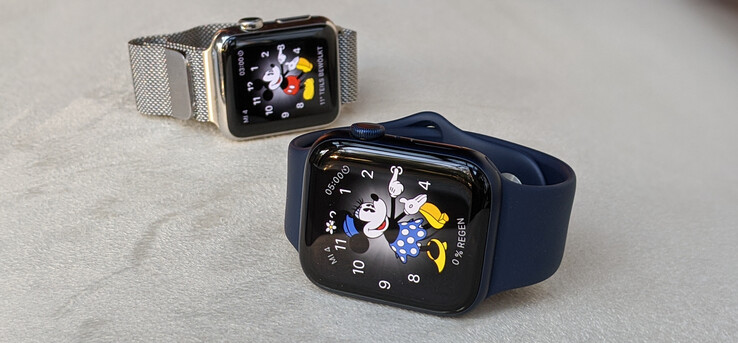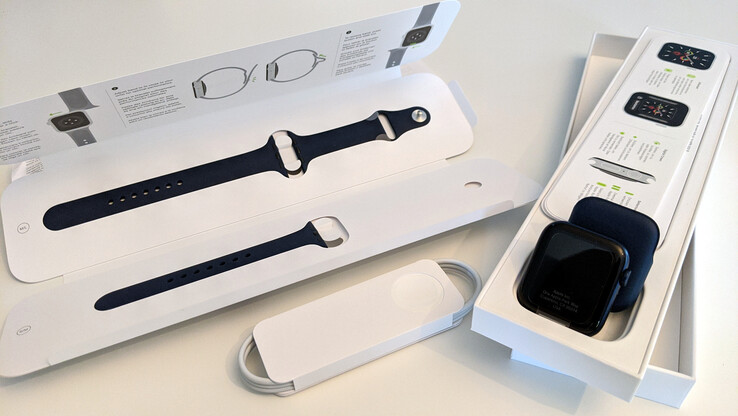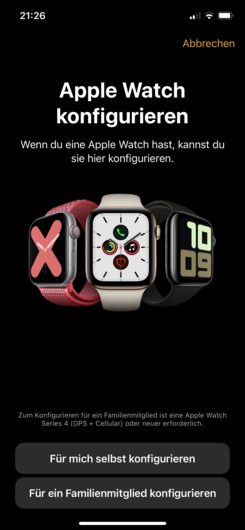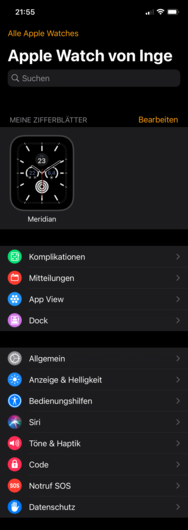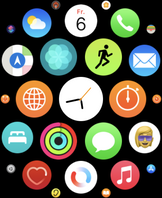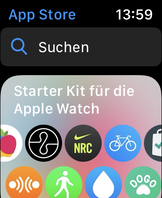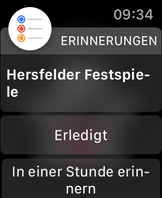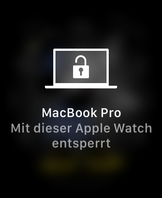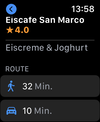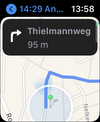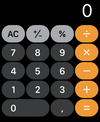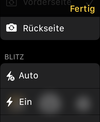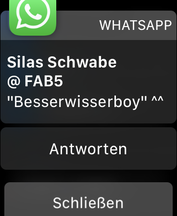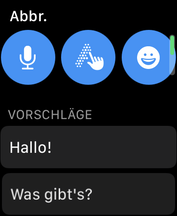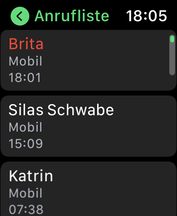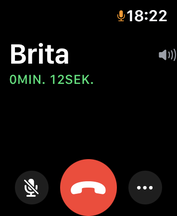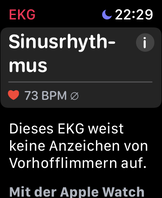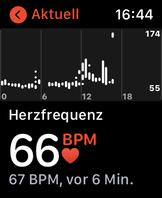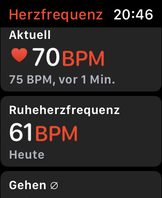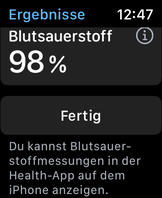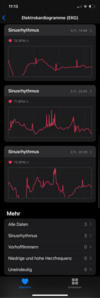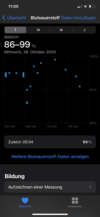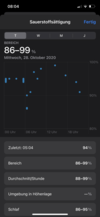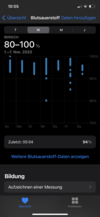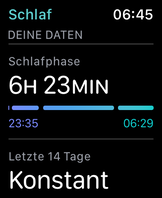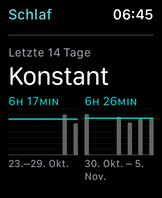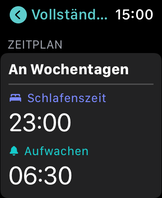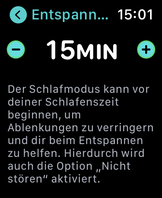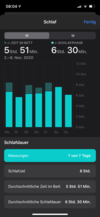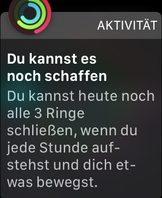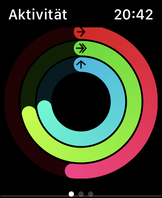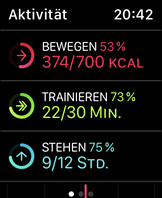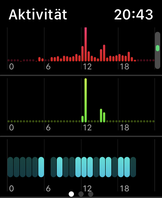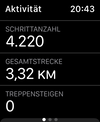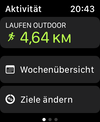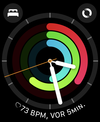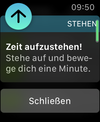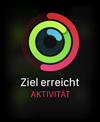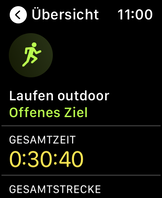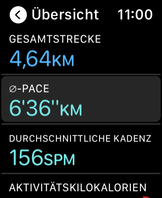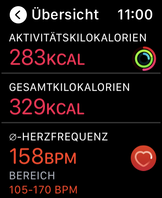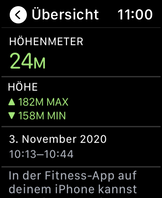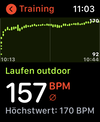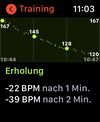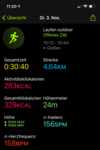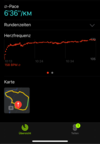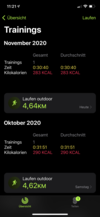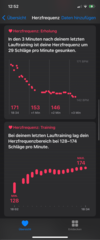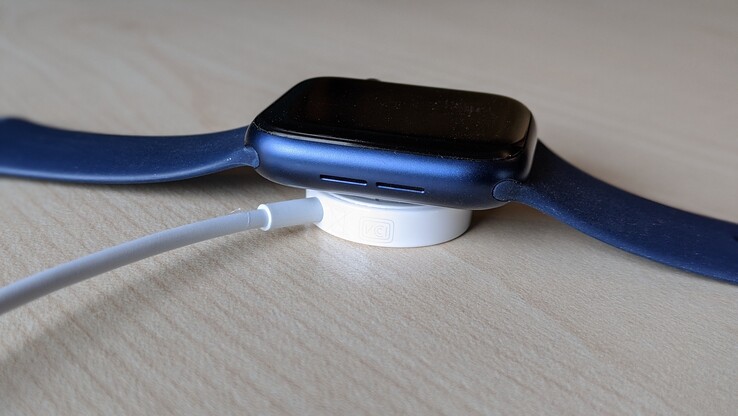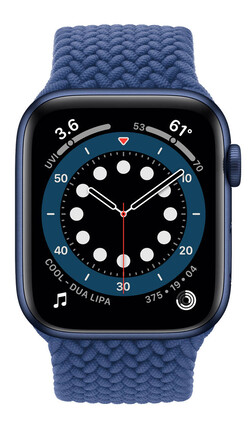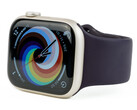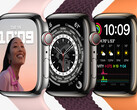Apple Watch Series 6 in Review: Improved Health Metrics Thanks to watchOS 7 and New Sensor
Case and Connectivity – Begone, Force Touch
As can be seen on our title photo above with a 2015 Apple Watch for comparison, the Watch’s form factor remained unchanged and current sizes are identical to last year’s model. The new eye-catching features are new colors, in particular the new blue and red aluminum case, and the new solo loop bands.
As before the aluminum models feature Ion-X glass while the stainless steel and titanium models come with Sapphire glass instead. The LPTO OLED that was first introduced with the Watch Series 4 remains well usable in sunlight. According to Apple, its Always-On Display’s maximum brightness has been improved by 2.5x over the Watch Series 5, which is supposed to be beneficial mostly to those who cannot raise their arm during their workout for whatever reason. We were particularly impressed by how fast the new device switched between the two modes. Even with Always-On Display enabled activating the full display when lifting your arm takes a split second.
The rear side has been updated to include the new sensor. The new sensor array is comprised of a crystal with four photo diodes and four green/red/infrared LED clusters. This array now allows for estimating your blood oxygen level as well as measuring and recording your heart rate, your heart rhythm, and recognize when you’re asleep. The latter does not require the new sensor and is thus available on all models that can be updated to watchOS 7, namely Series 3 and newer.
However, updating to watchOS on previous Apple Watch models comes at a price. The latest iteration of Apple’s mobile operating system no longer supports Force Touch, which in previous versions was used to access context menus or customize the currently installed watch faces. Instead, this way of input was now partly replaced with a long touch without applying extra force. The Apple Watch Series 6 lacks the Force Touch gasket that was still present on previous models, and on all older devices its readings are simply ignored.
The Apple Watch Series 6 supports GPS and is ISO 22810:2010 certified against ingress of water up to 50 m. The new Wi-Fi chip now also supports 5 GHz bands. Furthermore, the watch comes with NFC for Apple Pay as well as a speaker and microphone for Siri and phone calls. As before, an LTE model with eSIM support is available optionally at a premium.
Setup and Handling
Setting up an Apple Watch cannot be done with an Android smartphone as it requires a compatible iPhone. However, thanks to watchOS 7’s new family setup feature this no longer needs to be your own iPhone. Instead, you can now use any compatible iPhone to setup an Apple Watch for example for your children, senior parents, or others that don’t even own an iPhone. The Watch app required for pairing and setting up the Apple Watch is preloaded on any iPhone by default and is capable of managing multiple watches if necessary.
The Watch itself comes with numerous preloaded applications, such as for example a remote-control application for the iPhone’s camera. One of the Apple Watch’s largest benefits is its App Store ecosystem with a large variety of third-party applications. If an iPhone app also happens to support the Apple Watch it is automatically installed on a compatible Watch as well, as long as this feature remains enabled.
The watch faces can be customized either via the Watch app on the iPhone or on the watch itself. Changing between the various installed watch faces can be achieved with horizontal swipes across the screen. The digital crown is used for scrolling through settings menus or zooming in the Photos app. The single button can be used to either display the Dock, which contains all recently used applications, or a customizable list of favorite apps.
This all isn’t new by any means. Its ease of use is one of the basic principles defining the Apple Watch, as is the full integration of multiple Apple products logged in with the same Apple ID with one another. For example, should Siri respond to one of your questions with a search and website suggestion you can open this website on your Mac thanks to Handoff. Furthermore, all Siri suggestions and open websites are synchronized with your Mac to be found in Safari’s history. In addition, you can also use your Apple Watch to unlock your Mac. Once setup the watch will vibrate and play a sound reminiscent to that of a vault opening every time it unlocks your Mac. A nice touch for sure.
Notifications and Telephony
By default, the Apple Watch mirrors your iPhone’s notification settings, which can be later customized and adjusted to your liking. WhatsApp messages will display emojis but only a blurry preview of photos. Replies can contain either predefined blocks of text, emojis, a dictated message, or a digitized message with each letter scribbled onto the watch’s display. New messages can only be sent out as text, not as WhatsApp message. This holds true for all other messengers that don’t offer a native Apple Watch app.
You can take a phone call directly from the watch on your wrist, and you can also make phone calls through either your contacts, your recents, or a dialpad. While the LTE model is capable of operating independently of the iPhone it is paired to the GPS/Wi-Fi model requires the iPhone to remain close-by.
Health and Fitness – Finally with SpO2 Sensor
Fitness buffs love the Apple Watch, and the health sector was impressed by the Apple Watch Series 4’s ECG feature. And while other OEMs seem to struggle with reliable ECG data – Samsung’s implementation, for example, was delayed repeatedly and remains unavailable in many countries, including Germany, to this day – an increasing number of wearables started featuring blood oxygen saturation (SpO2) sensors capable of detecting possible sleep apnea. Apple, on the other hand, only supported heart rate and frequency (ECG) metrics as well as an app for hearing health. With watchOS 7, a sleep tracker is now finally available for all supported Apple Watches (Series 3 and later), and the Apple Watch Series 6 finally supports blood oxygen saturation monitoring.
Heart Frequency, Heart Rate, and Oxygen Saturation
By default, the ECG app is not available on an Apple Watch. Instead, it must be actively setup in the paired iPhone’s Health app where you can decide whether you want constant and automatic or manual heart rate and blood oxygen readings. Should the Watch detect atrial fibrillation, which is often linked to an increased risk of suffering a stroke, it will issue a warning.
Heart frequency measurements are very accurate. In our test, the Apple Watch was capable of accurately measuring our heart frequency both when idle and working out with increasing performance, and it reported values almost identical to that of a heart rate chest strap. When analyzing the workout data, we found almost identical data save for a single heartbeat.
On average, blood oxygen level data differed from that recorded by a certified pulse oximeter by just 1.5 % with a maximum of up to 3 %. Using the Blood Oxygen app on your watch you can start a manual reading of your blood oxygen levels. If needed the watch can automatically take readings several times a day and while asleep. The paired iPhone’s Health app will then graph that data over the course of days, weeks, or months.
Sleep Tracking
For the first time in the history of watchOS the new version 7 natively supports sleep tracking at night. However, when compared to sleep tracking data recorded by devices such as the Samsung Galaxy Watch 3, the Fitbit Sense, or Honor/Huawei wearables such as the Honor Magic Watch 2 or TicWatch Pro 3 GPS Apple’s data is poor at best. The tracker is even incapable of properly distinguishing your sleep phases (light sleep, deep sleep, REM sleep) from one another.
What it is capable of recording is the time you fell asleep, the time you woke up, and how often and when you awoke at night. This data can be graphed and analyzed long-term over the last few days or weeks and will inform you whether or not you reached your self-defined sleep goal for weekdays and weekends. Despite the fact that heartrate and oxygen saturation data is available for that same time period a sleep diagram overlay is not available. In addition, unlike Fitbit’s algorithms Apple’s infrequent readings will be barely able to reliably detect sleep apnea.
We suspect that more frequent readings would decrease the Apple Watch’s battery life even further. At the time of writing the minimum charge required for a night’s worth of sleep tracking is 30 %. Charge levels below 30 % will result in a warning. How and why the Apple Watch Series 6 managed to record more time asleep than time spent in bed (see last screenshot) remains a mystery to us. We can positively assure you with absolute certainty that the number of power naps taken during the review period was unfortunately exactly zero.
Activity Rings
Another Apple Watch feature is its ability to motivate users to spend less time sitting and more time moving with its Activity app. The goal is to close all three rings every single day: stand, move, and exercise. Standing is primarily aimed at avoiding long-term sitting and requires you to get up at least once every hour and move around for at least one minute. It will also count towards your move goal, as will taking a letter to the mailbox on foot instead of by car.
The exercise goal can best be reached through workouts that can be recorded with the preinstalled Workout app. If you’re not a big fan of gyms or indoor sports facilities, you can alternatively also reach your daily exercise goal and close the ring with a 30-minute long brisk walk. Basically, anything you can record with the Workout app or any other Apple Health-compatible fitness app will count towards your exercise goal. The app will also calculate your daily calories by adding up all exercises, steps taken, etc. The app store contains numerous apps that allow you to record your calorie intake as well and use that data fed into the Health app to record and monitor your weight.
Workout Tracking
At the time of writing, Apple’s Workout app supported slightly less than 100 different workouts. Running can be paused automatically if you stop or, alternatively, manually by pressing the digital crown and side button simultaneously and then terminating the workout via touch button on the display.
Thanks to its built-in GPS the watch is capable of recording your track even without an iPhone present. Music and audio books that have been previously synchronized with your watch can be played during your workout on any compatible Bluetooth headset.
Today’s workouts can be found in the Activity app on the watch. Analyzing older workouts requires the Fitness and Health app on the paired iPhone. The latter will even display heart rate and frequency during your workout session as well as during the resting period immediately afterwards. Unfortunately, this data is also only available for the current day.
Various alternatives to Apple’s Workout app are available in the app store, such as for example Strava or other apps aimed at running, swimming, or golfing. Those apps are great for keeping long-term records in order to use these metrics for improvement.
Performance Comparison
According to Apple, the Apple Watch Series 6’s S6 chip is supposed to be up to 20 % faster than the Apple Watch 5’s S5 chip. Truth be told we were unable to tell the difference in everyday use. Both watches performed all tasks very quickly.
| Sunspider - 1.0 Total Score | |
| Apple Watch 5 40 mm Aluminium | |
| Apple Watch 5 44 mm Stainless Steel Cellular | |
| Apple Watch Series 6 44 mm | |
| Average Apple S6 (n=1) | |
| Average of class (39.4 - 9121, n=1299) | |
* ... smaller is better
Battery Life – No More Than 2 Days Even Without Always-On Display
While other OEMs aim to improve battery life over time Apple is still content with an official battery life of 18 hours. The 44 mm Apple Watch Series 6 outperformed this official goal by 75 % and ran up to 31 hours and 40 minutes with enabled always-on display. And while not particularly impressive it should be more than enough to use the watch at night for sleep tracking even after a very long day.
If you are out and about and need to get through two days without recharging, you can opt to disable the always-on display. With that feature disabled we were able to squeeze out 2 days and 5 hours of battery life.
With GPS and heartrate sensor active at the same time Apple claims a battery life of up to 7 hours, or 6 hours for the cellular model. If the watch is connected to an iPhone it will use the latter’s GPS instead. Thus, you can easily plan long-lasting outdoor activities or extensive route tracking as long as you keep your iPhone nearby.
Verdict – The New Hardware is Great, the Software Experience Is Not
Making and taking phone calls, paying, listening to music, downloading popular apps from the app store – the Apple Watch has many benefits indeed. However, is switching to the new Series 6 justifiable if you already own an older model?
The SpO2 sensor’s data is more reliable than on many other devices. In addition, the Apple Watch allows you to have both manual and automatic readings enabled, which is seldom to be found on its competitors. Among others, one such contender is the Garmin Forerunner 745. The optical heart frequency sensor turned out to be very precise and accurate as well. The Apple Watch’s hardware is at the high level that we have grown accustomed to from Apple. However, the software is not there quite yet, particularly when it comes to Apple’s admittedly first implementation of sleep tracking. It simply does not record enough data for any sort of useful analysis.
The Apple Watch’s SpO2 sensor is a high-quality sensor. Apart from that, the differences to the Apple Watch Series 5 are minor at best.
Switching from the AW5 will only pay off if you are interested in the additional health data provided by the SpO2 sensor. Apart from the Apple Watch Series 6 Apple also lists two models without SpO2 sensor, ECG sensor and always-on display: The Apple Watch Series 3, starting at $199, and the Apple Watch SE, starting at $279.
The Apple Watch Series 6 with 44 mm display currently starts at $429 plus tax with various retailers already offering lower prices and holiday sales already. Apart from Samsung’s Galaxy Watch 3, which costs between $400 and $500 as well, most other wearables are much cheaper.




